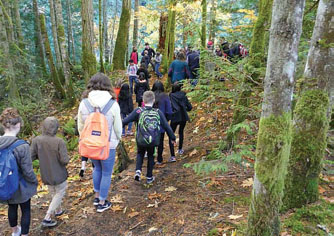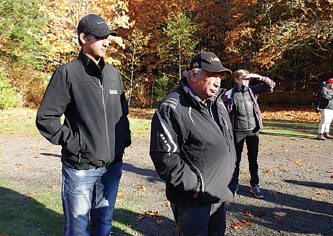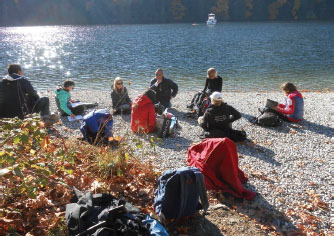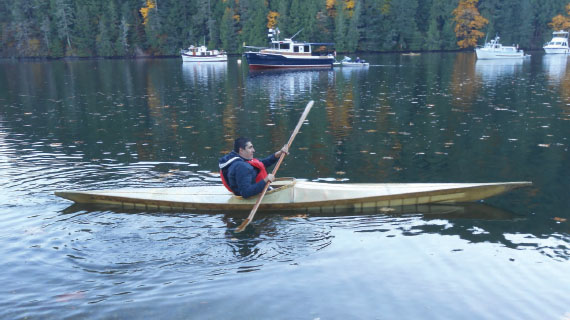
The Canada C3 team arrives at Tod Inlet by Zodiac, escorted by the Sidney Royal Canadian Marine Search and Rescue team from the C3 ship, Polar Prince, anchored at Brentwood, October 2017. Beverley Hall photograph.
In 2017, when Canada celebrated its 150th year since Confederation, one of the celebratory programs was the Canada C3 (Coast to Coast to Coast) Expedition. This voyage began in Toronto, travelled east down the St. Lawrence and around the Maritimes, north to Baffin Island and west through the Northwest Passage, then south along the west coast before arriving in Tod Inlet on October 28, 2015.
It was the last stop before C3’s arrival at Victoria, its final destination, on the 150th day. There could not have been a more suitable place to gather and reflect together on Canada’s history, in all its richness and challenges. The deep and sheltered waters of Tod Inlet hosted not only the 30 participants on that leg of the C3 journey, but also First Nations representatives, descendants of the workers at the cement factory—including one Sikh family—local schoolchildren learning hands-on about their nation, Butchart Gardens staff, provincial member of the legislative assembly and Tsartlip First Nation member Adam Olsen, federal member of Parliament Elizabeth May, and Catherine McKenna, minister of the environment.
As a member of the C3 Expedition planning team, I had proposed a stop at Tod Inlet right from the very beginning. On that remarkable October day when the ship arrived, I could not have been more pleased with, or proud of, our community. The First Nations participants who gave their thoughts on reconciliation; the teachers and students who came to learn together; the SeaChange Society members who have showed such dedication to helping the recovery of the environment; the descendants of the cement company’s immigrant workers who shared their heartfelt memories—all contributed to the great success of the event.

The Canada C3 team arrives at Tod Inlet by Zodiac, escorted by the Sidney Royal Canadian Marine Search and Rescue team from the C3 ship, Polar Prince, anchored at Brentwood, October 2017. Beverley Hall photograph.

Students from Royal Oak Middle School at the site of the Chinese and Sikh village at Tod Inlet, October 2017. Beverley Hall photograph.

Nicholas Singh Johal and his grandfather Paul Singh Johal, with Canada C3 participants at Tod Inlet, October 2017. Beverley Hall photograph.
Perhaps C3 artist Karen Tamminga-Paton best expresses the magic of that afternoon on Tod Inlet’s shores:
I had no idea, when our small C3 crew landed on the sandy shores of Tod Inlet, of the rich and troubled human history hidden amongst the thick cedar and maple canopy. David Gray was our guide. We walked the trails, heard the stories, saw remnants of the immigrant workers who once lived here and worked long shifts at the Portland Cement Company. Our trail then led us to the famous nearby Butchart Gardens. I was especially inspired by the account of Jennie Butchart, wife of the cement plant owner, who hated the sight of the excavated limestone quarry and did everything in her power to bring beauty to that ravaged landscape. She planted flowers. She accessed steep banks with ladders and ropes to carefully place vines and shrubbery. She planted trees, and she ceaselessly tended them all. Eventually, this gaping and wounded landscape became the famously beautiful destination that it is today.
In some ways, David Gray’s insights are like the work of Jennie Butchart who lived a century before us. Like Jennie gathering her plants, David gathered stories and fanned them into life. The landscape is quiet there at Tod Inlet, protected from offshore winds and urban noise, yet as David talked, one couldn’t help but be more attentive. It was so much more than just a lovely walk through a gorgeous forest. And it wasn’t much of a stretch to imagine the old cedars leaning in as though to say, “did you catch that”? We listened, imagined, witnessed, and shared responses together, all of us deeply impacted. David’s humble curiosity, sharp eye and ear and suspension of judgement modelled for us how to be in that space. As Canadians, we all need to understand these stories that give any given piece of geography within our borders its particular tenor and character. We will occupy it very differently when we do.

Canada C3 group on the new beach. David R. Gray photograph.

Ahmed Saffar, a Canada C3 participant from Calgary, takes his first trip in an Inuit-style kayak from the beach at Tod Inlet out to the C3 ship in Brentwood Bay, October 28, 2017. David R. Gray photograph.
Map of the Tod Inlet community showing the cement plant and the villages as they were in the 1920s. Map and key by Philip Wilson and David R. Gray, 2002.
Waterfall at Tod Creek. Note the old waterline pipe. David R. Gray photograph.